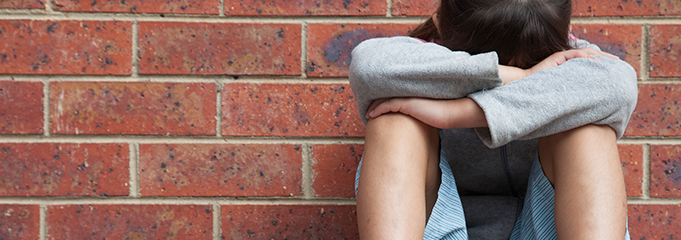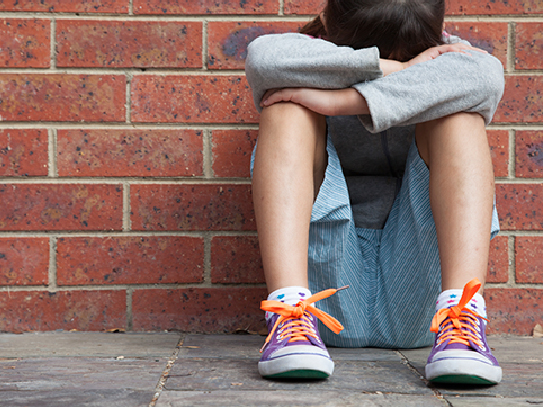
School Bullying Trauma – An Overview

This article was authored by Evelyn Field, psychologist, professional speaker, best selling author and regular media commentator who has spent over forty years dealing with school and workplace bullying.
 Although most schools try to reduce bullying, one in five children still experience bullying (Rigby). For some children, the trauma of being bullied, their biopsychosocial injuries, loss of identity and social connections together with a potential for suicidal behaviours, is a major childhood challenge.
Although most schools try to reduce bullying, one in five children still experience bullying (Rigby). For some children, the trauma of being bullied, their biopsychosocial injuries, loss of identity and social connections together with a potential for suicidal behaviours, is a major childhood challenge.
The DSM V mentions workplace bullying, harassment and ostracism, but omitted school bullying! No wonder that mental health professionals, schools and society don’t take school bullying seriously! Yet the media and Google constantly expose tragic school and cyber bullying stories. There are many websites about school bullying, eg NCAB, (Australia), Stop Bullying, (USA), Kidscape (UK) and Prevnet, (Canada). They share a common lack of detail about the physical, psychological, social and cognitive symptoms and the possible impact into adulthood.
My paper will introduce some issues that the DSM V has neglected. But first let us imagine what being bullied feels like? Strange how most people clearly recall instances of bullying from years ago, but find it harder to recall the presents they received that Xmas! It would seem that bullying is an indelible experience, remembered forever. We need to understand what it feels like and what it means to the target, to be the receiver of nasty knocks, mean verbal attacks, overt exclusion or subtle roll of the eyes? Once isn’t nice, but numerous occasions may lead to psychological and physical implosion.
Damage
Unlike many other forms of violence, some bullying behaviours are subtle, yet their injuries can be long- term and life changing. Basically school bullying affects physical health, emotional & social well-being. It can impact upon schoolwork and career choices, interfere with normal socialising, eg shyness, social difficulties, dating. It can impact on the bully, bystanders, family and society. Bullying damages the brain, it causes psychological injuries, eg anxiety, depression, PTSD, suicidal behaviours and changes personality. The impact can extend into adulthood for targets and bullies.
It is not just the bullying events that cause the injury but the bullied person’s perception, beliefs, personality, reactions, life experiences that threaten them, altering their physical and emotional wellbeing.
Pernille (2005) found that school bullying causes physical and psychological symptoms. Bussey (2010) found outcomes ranging from a variety of minor to severe psychological disturbances. Knack, (2014) “Social pain brought on by rejection and victimization predicts hormonal changes that can lead to health problems, such as high blood pressure, abdominal pain, headaches and joint pain.”
According to Anthens (2010) “Bullied brains showed observable abnormalities in corpus callosum — vital in visual processing, memory, and more.” “There may be subtle neurocognitive difficulties”. “Being ostracized by one’s peers, throws adolescent hormones out of whack, lead to reduced connectivity in the brain, & sabotages growth of new neurons.” Vaillancourt (2011) noted deficits in prefrontal executive functions and medial temporal lobe memory functions.
The damage may persist into adulthood
Tragically, the physical and psychological symptoms that result from school bullying may persist into adulthood. Arseneault (2008) believes that abusive experiences, may lead to the appraisal of normal events as threatening, thus bullying can trigger a cycle of victimisation that lasts a lifetime. While Pynoos et al. (2009) is concerned about the fact that school bullying occurs during childhood and adolescence and its impact on the youngster’s developing bio- psycho-social systems are not known.
 Vaillancourt (2013) concludes “peer victimization impacts upon biological functioning” and “creates ghosts in the genome that can affect future mental and physical health, as well life longevity”. Copeland (2013) cites the long term effects as does Wolke (2013) who writes, “Being bullied is not a harmless rite of passage but it throws a long shadow over affected people’s lives. Involvement with bullying in any role was predictive of negative health, financial, behavioral, and social outcomes in adulthood.” Lereya (2013) encourages health practitioners evaluating self-harm to regard “being bullied an important potential risk factor.”
Vaillancourt (2013) concludes “peer victimization impacts upon biological functioning” and “creates ghosts in the genome that can affect future mental and physical health, as well life longevity”. Copeland (2013) cites the long term effects as does Wolke (2013) who writes, “Being bullied is not a harmless rite of passage but it throws a long shadow over affected people’s lives. Involvement with bullying in any role was predictive of negative health, financial, behavioral, and social outcomes in adulthood.” Lereya (2013) encourages health practitioners evaluating self-harm to regard “being bullied an important potential risk factor.”
Schuter (2013) believes that bullying can lead to depression, anxiety, posttraumatic stress, and suicidal ideation. Takizawa, (2014) “Bullied children are at greater risk of obesity, strokes and heart attacks later on.” Dieter Wolke (2015) “Our findings suggest that being bullied has similar and in some cases worse long-term adverse effects on young adults’ mental health than being maltreated.”
Thus bullying changes how our genes work and how they shape our lives, and likely what we pass along to future generations.
Reasons
Why is bullying so bad? I believe that bullying symbolises personal humiliation and ostracism from the tribe. It threatens our survival instinct and forces us into survival mode. Campbell’s (2004) research reveals that the primary fear of adults, children and adolescents is fear of negative social outcomes. Williams (2011) states that “ Humans need to belong. Yet they also commonly leave others out. Animals abandon the weakest to ensure the survival of the fittest. Common though they are, rejection and exclusion hurt. Endured for a long time, ostracism leaves people feeling depressed and worthless, resigned to loneliness or desperate for attention—in extreme cases, suicidal or homicidal.”
Bullying is a social pain. Eisenberger (2012) states “ the painful feelings associated with social disconnection -rely on same neurobiological substrates that underlie experiences of physical pain. Liberman (2013) “Social neuroscience reveals that our need to connect with other people is even more basic than our need for food or shelter. Social connection is essential for survival. Our brains react to social pain & pleasure as they do for physical pain and pleasure. Social rejection/humiliation causes social pain.”
 Rossouw (2012) writes “Bullying cuts a channel of despair, hopelessness and a low sence of self that up regulates emotional & physical distress leading to increased fear & stress response. Violation of basic needs shifts neurochemical balances & neural connections resulting in significant changes. This reduces effective brain functioning resulting in decreased physical, emotional, social, cognitive & neural wellbeing.”
Rossouw (2012) writes “Bullying cuts a channel of despair, hopelessness and a low sence of self that up regulates emotional & physical distress leading to increased fear & stress response. Violation of basic needs shifts neurochemical balances & neural connections resulting in significant changes. This reduces effective brain functioning resulting in decreased physical, emotional, social, cognitive & neural wellbeing.”
DSM V
Prior to the publication of the DSM V, (2009) I assumed that child experts worldwide would promote the dangers of school bullying. But nobody did! The DSM V only mentions discord with peers! I don’t know who sent in research about workplace bullying, but I did. Thus I was thrilled to see humiliation, ostracism and bullying included, although school bullying wasn’t! Apparently the DSM V is less than accurate and child therapists need to investigate further.
Following publication of the DSM V, I sought clarification from Dr Mathew Friedman, Chair DSM V Trauma committee, (14.6.2013) he replied,
“I don’t believe bullying, per se is mentioned but the PTSD criteria clearly cover bullying when there is actual, or the threat of, harm to an individual.”
Diagnostic issues
Six months ago I experienced what doctors described as a minor heart attack, but was given four stents! Although I recall the chest pressure, and a thought flashed through my mind that I could die in the street, I then decided that it was indigestion or hunger. I called the ambulance a few hours later! But it has taken over six months for me to acknowledge the event as possibly life-threatening. I am still not sure if it was!
The highly validated Breslau Scale for PTSD (1999) doesn’t use Criterion A, others argue that Criterion A could include less severe, but serious life events such as bullying. (Matthiesen & Einarsen 2004). Brewin et al.2009; Kraemer et al. 2009 ) Research by McPharlane (2009) demonstrates that Rater perception determines Criterion A, not victim’s experience!
Can school bullying be regarded as life threatening?
Joseph (2003) found that a third of bullied children suffered post-traumatic stress. Teicher (2010) found that bullying is associated with greater symptom ratings and meaningful alterations in brain structure. Research into identical twins, some of whom were bullied, expose epigenetic differences between non-bullied and bullied twins to survive the bullying, Arseneault (2011) Idsoe (2012) and Moalem, (2014).
A meta-analysis by Nielson et al (2015) demonstrates that 57% of bullied victims report symptom scores for PTSD. The meta-analytical part of their study showed that exposure to bullying at work and school was significantly associated with posttraumatic stress symptoms.
Workplace Bullying Trauma, (WBT)
The recent research into diagnosing and treating victims of Workplace Bullying Trauma (WBT) by the Therapist Special Interest Group, part of the International Association on Workplace Bullying and Harassment, (IAWBH) can be utilised towards developing a better understanding of school bullying trauma. WBT is identified by a constellation of symptoms including rumination, hypervigilance, paralysis, weight gain, sleep, gastrointestinal and skin disorders, concentration & social difficulties and personality change.
School bullying trauma
Numerous researchers such as Ziegler (2002), Van der Kolk, Weisaeth, & McFarlane, (2007) regard bullying as a possible cause of PTSD. According to Idsoe (2012) since “newer versions of the A1 criteria have emphasized perceived life threat, many bullied children would qualify under this criterion.” “Our findings support the idea that exposure to bullying is a potential risk factor for PTSD symptoms among students.” As bullying represents a relational trauma it can be more traumatic than other traumas, (Lancaster et al. 2009).
Therefore being humiliated and ostracised is life threatening! Evidence demonstrates that bullying can change a child’s life forever and alter their brain.
Thus I would like to propose that school bullying, like workplace bullying, may be life threatening and cause PTSD. If left untreated, it can traumatise the young person, alter their neurobiology, change their physical health and social well-being permanently.
Where to from here?
Although school-bullying theory proceeded workplace-bullying theory, there’s scant mention of diagnosis and treatment of school bullying victims, apart from the publications by Evelyn Field OAM and Dr Pam Carroll.
Although treating childhood bullying is simple if dealt with immediately, (2-6 sessions) when bullying symptoms persist into adulthood they become extremely difficult to treat. Thus we need evidence-based training for mental health professionals to take school bullying seriously. We also need to educate and empower children themselves to block bullies and prevent it occurring again, at school or later on.
References
Louise Arseneault, Ian Kelleher, Michelle Harley, Fionnuala Lynch, , Carol Fitzpatrick and Mary Cannon, Associations between childhood trauma, bullying and psychotic symptoms among a school-based adolescent sample The British Journal of Psychiatry (2008) 193, 378–382.
Louise Arseneault, Isabelle Ouellet-Morin, . Andrea Danese, Lucy Bowes,. Sania Shakoor, Antony Ambler,. Carmine M. Pariante, Andrew S. Papadopoulos, Ph.D. Avshalom Caspi, Terrie E. Moffitt,
A Discordant Monozygotic Twin Design Shows Blunted Cortisol Reactivity Among Bullied Children June 2011 Volume 50, Issue 6, Child and Adolescent Psychiatry
Emily Anthes , Inside the bullied brain -The alarming neuroscience of taunting. Bostin Globe (2010)
Breslau, N., Peterson, E.L., Kessler, R.C., Schultz, L.R. (1999). Short screening scale for DSM-IV post-traumatic stress disorder. American Journal of Psychiatry, 156, 908-11.
Barchia, K., & Bussey, K. (2010). The psychological impact of peer victimization: Exploring social-cognitive mediators of depression. Journal of Adolescence, 33, 615-623, 2010.
Campbell, M.A. (2004). School victims: An analysis of ‘my worst experience in school’ scale. Performing Educational Research: Theories, Methods and Practices. Flaxton, Australia: Post Pressed Flaxton.
Carroll, Pam, Dr, ‘Peer teasing and victimisation of young people with craniofacial conditions: advancing interventions.’, Flinders University 2007
Sharon Moalem M.D., Ph.D. Bullying’s Terrible Legacy: How Childhood Stress Can Change Our Genes Forever Posted: 04/14/2014
Arch Gen Psychiatry 2009 Sep;66(9):1005-12
Andre Sourander, John Ronning, Anat Brunstein-Klomek, David Gyllenberg, Kirsti Kumpulainen, Solja Niemelä, Hans Helenius, Lauri Sillanmäki, Terja Ristkari, Tuula Tamminen, Irma Moilanen, Jorma Piha, Fredrik Almqvist
Robert S. Pynoos, Alan M. Steinberg, and Christopher M. Layne
Ernestine C. Briggs, Sarah A. Ostrowski, and John A. Fairbank
Journal of Traumatic Stress , Vol. 22, No. 5, October 2009, pp. 391–398(2009) DSM-V PTSD Diagnostic Criteria for Children and Adolescents: A Developmental Perspective and Recommendations
Rigby, Ken, Assoc. Prof. National Coalition Against Bullying, Presentation, October 2015
Olweus, D. (1978) Aggression in the schools. Bullies and whipping boys. London, John Wiley & Sons.
Eisenberger NI, Lieberman MD, Williams KD. Does rejection hurt? An fMRI study of social exclusion. Science. 2003;302:290–92.
Journal of the American Academy of Child & Adolescent Psychiatry
Volume 52, Issue 6 , Pages 608-618.e2, June 2013
Being Bullied During Childhood and the Prospective Pathways to Self-Harm in Late Adolescence , Suzet Tanya Lereya, Ph.D., Catherine Winsper, Ph.D., Jon Heron, Ph.D., Glyn Lewis, Ph.D., David Gunnell, D.Sc., Helen L. Fisher, Ph.D.,Dieter Wolke, Ph.D.
Lieberman MD. Social cognitive neuroscience: a review of core processes. Annu Rev Psychol. 2007;58:259–89.
Science News Making connection between bullying, health problems May 16, 2014, Clarkson University Clarkson University. Jennifer Knack, ( 2014)
The stressor Criterion A and PTSD:: A matter of opinion??
Miranda Van Hooff , Alexander C. McFarlane, Jenelle Baur, Maria Abraham, Daniel J. Barnes Journal of Anxiety Disorders Volume 23, Issue 1, January 2009, Pages 77–86
Dr Stephen Joseph , BBC News Wednesday, 16 April, 2003, Warwick University, Bullying and symptoms among school-aged children: international comparative cross sectional study in 28 countries. Pernille Due, Bjørn E. Holstein, John Lynch, Finn Diderichsen, Saoirse Nic Gabhain, Peter Scheidt, Candace Currie. The European Journal of Public Health, Eur J Public Health (April 2005) 15 (2):
Post-traumatic stress disorder as a consequence of bullying at work and at school. A literature review and meta-analysis, Morten Birkeland Nielsen,abTone Tangenc, Thormod Idsoed, eStig Berge Matthiesenf, b, Nils Magerøyg Aggression and Violent Behavior, Volume 21, March–April 2015, Pages 17–24
I Shalev, T E Moffitt, K Sugden, B Williams, R M Houts, A Danese, J Mill, L and A Caspi, Exposure to violence during childhood is associated with telomere erosion from 5 to 10 years of age: a longitudinal Study. Molecular Psychiatry 18, 576-581 (May 2013)
Pieter Rossouw , Bullying A Neurobiological Perspective, Neuropsychotherapy in Australia (2012)
Bullying and PTSD Symptoms Thormod Idsoe, Atle Dyregrov, Ella Cosmovici Idsoe J Abnorm Child Psychol (2012) 40:901- 911
Adult mental health consequences of peer bullying and maltreatment in childhood: two cohorts in two countries, Suzet Tanya Lereya, PhD William E Copeland, PhD Prof E Jane Costello, PhD Prof Dieter Wolke, PhD, 2015
JAMA Psychiatry. 2013 Apr 1; 70(4): 419–426. doi: 10.1001/jamapsychiatry.2013.504 Adult Psychiatric and Suicide Outcomes of Bullying and Being Bullied by Peers in Childhood and Adolescence William E. Copeland, PhD, Dieter Wolke, PhD, Adrian Angold, MRCPsych, and E. Jane Costello, PhD
Mark A.. Schuster. Laura Bogart, Did the Ugly Duckling Have PTSD? Bullying, Its Effects, and the Role of Pediatricians, Pediatrics Vol. 131 No. 1 January 1, 2013
Williams, D. Kipling, Ostracism: The Power of Silence (Emotions And Social Behavior) (21 September 2001) Kindle eBook
Takizawa R, Maughan B, Arseneault L. “Adult health outcomes of childhood bullying victimization: Evidence from a 5-decade longitudinal British birth cohort” is published in the American Journal of Psychiatry, 2014
Vaillancourt T, Hymel S, McDougall P. The biological underpinnings of peer victimization: Understanding why and how the effects of bullying can last a lifetime. Theory into Practice. 52: 241-248 (2013).
Van der Kolk, B. A., Weisaeth, A. C., & McFarlane, L. (2007). Traumatic stress: The effects of overwhelming experience on mind, body, and society. New York: The Guildford Press.
Field, Evelyn M, Bully Busting, Finch (1999)
Field, Evelyn M. Bully Blocking, Finch/Harper Collins (2007)
Martin H. Teicher, M.D., Ph.D., Jacqueline A. Samson,Ph.D., Yi-Shin Sheu, M.A., Ann Polcari, R.N., Ph.D., and Cynthia E. McGreenery Hurtful Words: Association of Exposure to Peer Verbal Abuse With Elevated Psychiatric Symptom Scores and Corpus Callosum Abnormalities Am J Psychiatry Published July 15, 2010
Thormod Idsoe & Atle Dyregrov & Ella Cosmovici Idsoe, Bullying and PTSD Symptoms, J Abnorm Child Psychol (2012) 40:901–911
The Biological Underpinnings of Peer Victimization: Understanding Why and How the Effects of Bullying Can Last a Lifetime Tracy Vaillancourt, Shelley Hymel & Patricia McDougall , 2013
Clinical Child Psychology and Psychiatry 1359–1045 (200001)5:1 Copyright © 2000 SAGE Publications (London, Thousand Oaks and New Delhi) Vol. 5(1): 77–83; 010968, Can Post-Traumatic Stress Disorder be
Diagnosed in Adolescence Without a Catastrophic Stressor? A Case Report, ANDREW WEAVER Macclesfield District General, UK
Impact of Bullying in Childhood on Adult Health, Wealth, Crime, and Social Outcomes Dieter Wolke, William E. Copeland, Adrian Angold, and
E. Jane Costello, Department of Psychology and Division of Mental Health and Wellbeing, University of Warwick, Department of Psychiatry and Behavioral Sciences, Duke University Medical Center, Psychological Science Online First, August 19, 2013
Kipling Williams, Ostracism hurts—but how? Shedding light on a silent, invisible abuse, Current Directions in Psychological Science, 2011.
Ziegler, D. (2002). Traumatic experience and the brain. Phoenix: Acacia Publishing, Inc.
